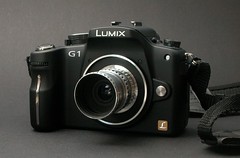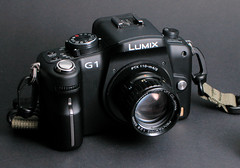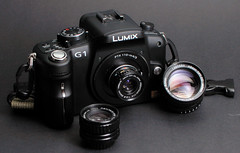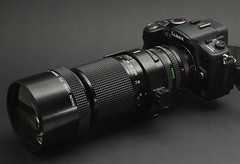I'm feeling that DSLR's are undergoing some sort of bloat, much like MS Word or Office twoThousand and whatever and that we're getting somehow used to it ... as if its normal proper and expectable. But first, I'll introduce a few things to couch my argument in before I make my point, please bear with me a little here.
 I used to mainly work with a 35mm camera, then added a 4x5 sheet film camera. It was fantastic for some things, but compared to the 4x5 the 35mm was compact and incredibly versatile.
I used to mainly work with a 35mm camera, then added a 4x5 sheet film camera. It was fantastic for some things, but compared to the 4x5 the 35mm was compact and incredibly versatile.I could pop 3 or 4 rolls of 35mm in my pack (weighing next to nothing compared to 4x5 holders) and then wander about with a setup which (strangely enough weighed the same as the 4x5) I could use easily and conveniently.
This enabled me to take quite reasonable quality images, and to get shots which I would probably not have taken with the slower and bulkier 4x5... for instance, this image was taken with my EOS and a plain old 24mm lens while walking around.
So there are benefits to compact and portable.
After 2001 I bought my first reasonably usable digital camera and suddenly the 35mm found itself in the cupboard most of the time. I think there are quite a few people who know that particular story.
Naturally enough I found myself wanting better images than my IXUS 200 was delivering (ok for small postcard prints but still with a digital look) but had been spoiled by light weight and small size of the digital. The problem was the digital was nice to carry around but didn't give me images which were good enough to make anything to put on the wall (or try to sell).
So I kept using my EOS film camera and waited to see what would happen in the market
 For some time I resisted the pull towards a DSLR because, apart from being bulkier than my EOS film camera and more expensive, I felt the smaller sensors (APS-C) did not give images with the right look for my taste. However it was just too handy and so I started using the 10D and 20D cameras in my photography.
For some time I resisted the pull towards a DSLR because, apart from being bulkier than my EOS film camera and more expensive, I felt the smaller sensors (APS-C) did not give images with the right look for my taste. However it was just too handy and so I started using the 10D and 20D cameras in my photography.I would often take a compact digital along too, as it really wasn't much more burden than even one the the lenses (the Tokina 12-24 sure is handy, but it isn't light ya know).
So along came the G1 which seemed to be exactly the camera I had been wanting all along. Light, compact, great image quality and inter-changeable lenses.
Great ... I could have a camera which
- was not limited by the standard lens (often quite enough, but sometimes its really important to do more with your images)
- was light weight
- very compact
- versatile and
- made excellent images that I could actually print 40cm wide






As you can see, not only that it is an interchangeable lens camera, but that it can accept lenses from almost anything.
With a growing collection of Olympus OM lenses around I impulsively bought an OM 10 just for the hell of it (and it was cheap). This lead me to a re-discovery ... just how compact the OM film cameras were.
the G1

and the an OM-10 35mm film SLR:

almost exactly the same size aren't they.
I found myself beginning a cycle of reflection and learning. By making comparison to the past with the present I was pondering how far we'd come.
I'm thinking now that while we've made some steps forward, some sideways and some backwards.
Since they say a picture paints a thousand words, I thought I'd start my case with a quick video introduction.
But wait ... this camera harks from the year 1979 ... that's more than thirty years ago.
 Now, this gets more interesting when I say that the Pentax 110 camera uses film with exactly the same size as the sensor on the G1 ...
Now, this gets more interesting when I say that the Pentax 110 camera uses film with exactly the same size as the sensor on the G1 ...Both are SLR cameras,
both have inter-changeable lenses,
both are fully auto exposure cameras
That's right ... the G1 is essentially the digital film version of the 110 film camera, although the G1 offers far more manual control over the exposure than the 110 does, and the 110 does not have autofocus. Say, there has been progress since 1979 after all!
In fact one of the images above (this one above) is exactly the Pentax 110 lens used in that video on the G1. It begins to look even small on the G1.
For example the lens above is a 50mm f2.8 lens, comparing the 110 lens to a 35mm lens (both on an adaptor to work with the G1) we see this:

So clearly the 110 lens is much smaller, lighter and more compact that of the 35mm camera. Actually as I found in this post the 110 lenses don't perform much differently to the larger 35mm lenses.
One of the "promises" of the micro 4/3 was to bring us more compact cameras and lenses.
Certainly these 110 lenses are compact (as is the camera), yet if we look at the equivalent lens in the micro 4/3'rds range they really aren't even this small.
 Now, if you look at a "standard" focal length for this format, like a 24mm, the Pentax 110 version of this is positively comically small.
Now, if you look at a "standard" focal length for this format, like a 24mm, the Pentax 110 version of this is positively comically small.On the micro 4/3 front, people rave on about how small the Panasonic 20mm is, but its nowhere near this small.
Sure, the Panasonic 20mm lens has a lens iris built in and an autofocus mechanism, but that tiny little silver one up there has an aperture built into it too ... and its not big
So what indeed have we done to ourselves?
Ok, I'm sure that the next thing people are going to say is I'm not comparing eggs with eggs ... so lets set a few things straight then.
The G1 sensor is exactly the same size as the film recording area of the Pentax 110, sure the quality of images from the G1 exceed the quality from the 110, but that's due to things like:
- film vs digital
- 110 film had dreadful film flatness issues

Same lenses on each (don't ask why do I have two Pentax 110 50mm lenses) ... the G1 micro 4/3 camera starts to look less compact when you put them together like that doesn't it ... recall they're both capturing the same size area sensor. The G1 even has a compact mirror-less design, while the Pentax 110 retains the mirror and penta-prism and is a regular optical SLR.
 If you then compare a 5D to my G1 or to an Olympus OM-10 you'll find that the OM-10 is a compact little thing, being the same size as the G1 compared the Godzilla of the 5D (wait till you put an extended battery pack on that 5D ... heh)
If you then compare a 5D to my G1 or to an Olympus OM-10 you'll find that the OM-10 is a compact little thing, being the same size as the G1 compared the Godzilla of the 5D (wait till you put an extended battery pack on that 5D ... heh)Oh ... yes, that's right ... its all that electronics which makes it all so huge isn't it. Well folks I'm sorry but if you believe that well ... I have this bridge which will make a great money making investment to offer you.
I mean seriously, what are the reasons that they need to be this big?
The 5D surely isn't empty space, but yet its much bigger than my film EOS 630 camera (from 1989) and that has an inbuilt 5 frames per second winder with AF which is nearly as fast (although less focus points to choose from) and a much better mode DEP (no, A-DEP doesn't cut the mustard).
Ok ... lets look at the electronics abstractly first:
 Here is a 3 megapixel camera which dates from nearly ten years ago.
Here is a 3 megapixel camera which dates from nearly ten years ago.As you can see its a comparable size to my Pentax 110, it houses an autofocus system, optical system, storage system (heck, even Compact Flash, not even something small like SD media is).
If we can't make anything more compact than this after ten years of trying, what the hell is happening?
I remember back in the 80's when I was a recording studio and concert engineer dreaming of something smaller than compact disk. I wanted there to be something compact and with no moving parts.
Give it up ... your a dreamer ... there are physical limits you know ...
 Yep I heard them all. Then one day in 2000 (ten years ago) I bought a new MP3 player, this is it.
Yep I heard them all. Then one day in 2000 (ten years ago) I bought a new MP3 player, this is it.Cute little fella, innit.
The size of a matchbox, and about as thick too. It ran all day on a single AAA battery and took two media cards which are exactly the same dimensions as the SD card my G1 takes today.
That was ten years ago.
So look at this MP3 player, the above IXUS camera and tell me again that we can't be makin them smaller than the G1 or even close to the size of that 1979 Pentax 110
This is not to say that I am unhappy with my G1 ... the opposite is true. I love it, its better than my 20D in so many ways (but not all of them) is as compact as my 35mm film camera was, takes comparable images and has better automation.
It is however hardly more "micro" than that system. So when it comes to digital and compact, taking into account the "promise" of micro 4/3; all I can think is folks we've been swindled.
so in my view we've brought digital cameras (and their advantages) to about the levels of where 35mm cameras were in 1989. Not bad in 12 years.
Perhaps in a few more years we can get back to where Pentax started to take us in 1979











1 comment:
While we are on this subject, why not a departure from the Leica rectangle body shape?
For the life of me, why can't modern cameras be housed in a simple, ergonomic, single-handed pistol-handle shape, with thumb and index wheels for controls and a squeeze shutter action!
If memory doesn't fail me, back in the 70s one of the Japanese movie camera makers came up with a similar design.
Never went far, for a great many reasons related to film reels themselves.
But applied to digital cameras, why not? I'd certainly look at something like that!
The Leica rectangle shape was never very ergonomic, hence why we need all those fancy molded right hand handles to give us some grip stability.
The human hand is designed to grab sticks. Not bricks!
Post a Comment